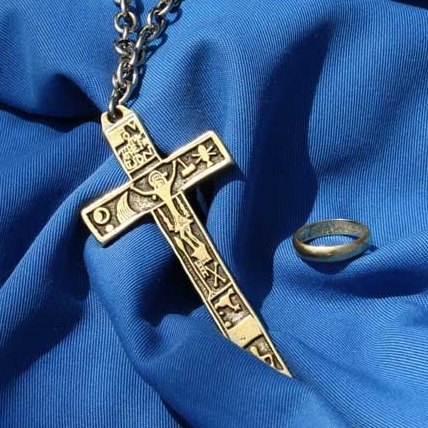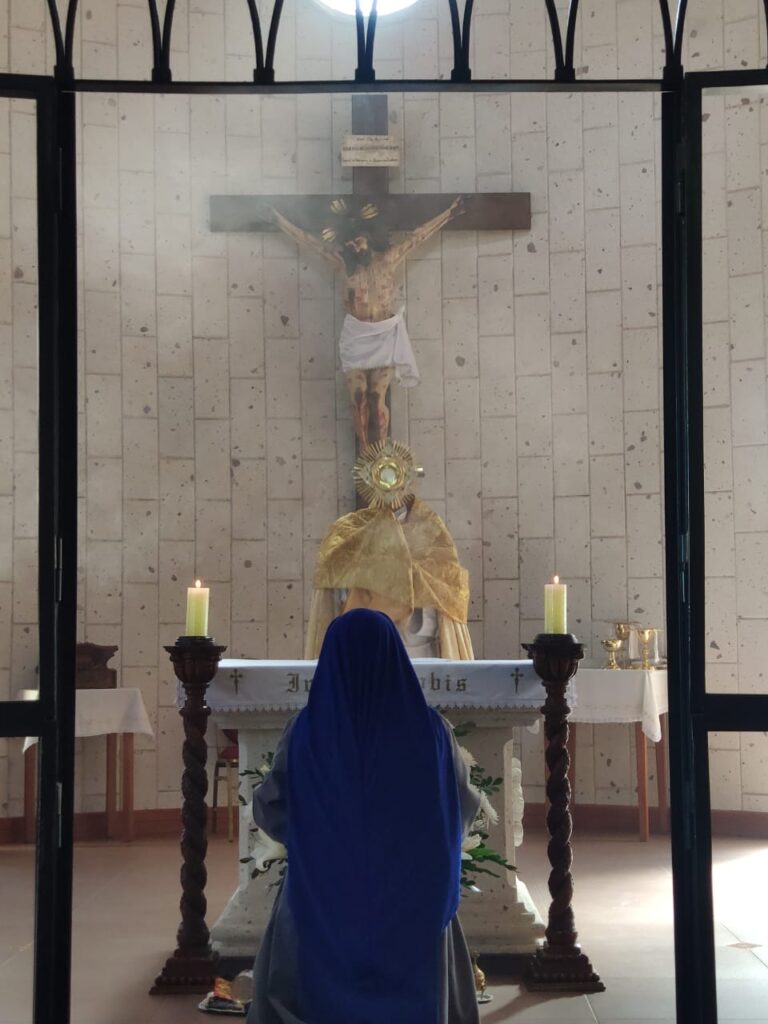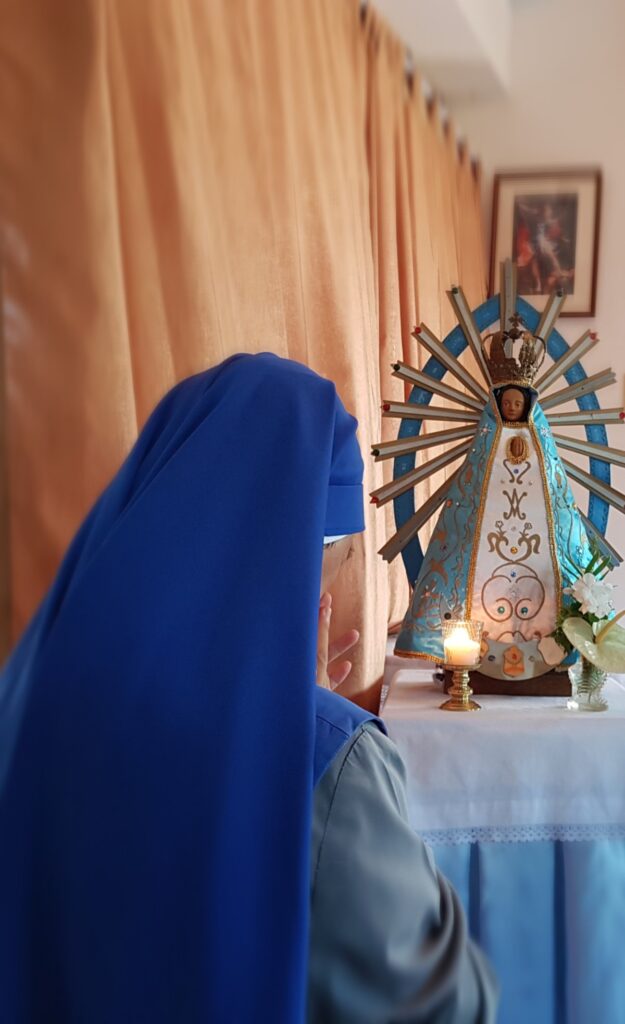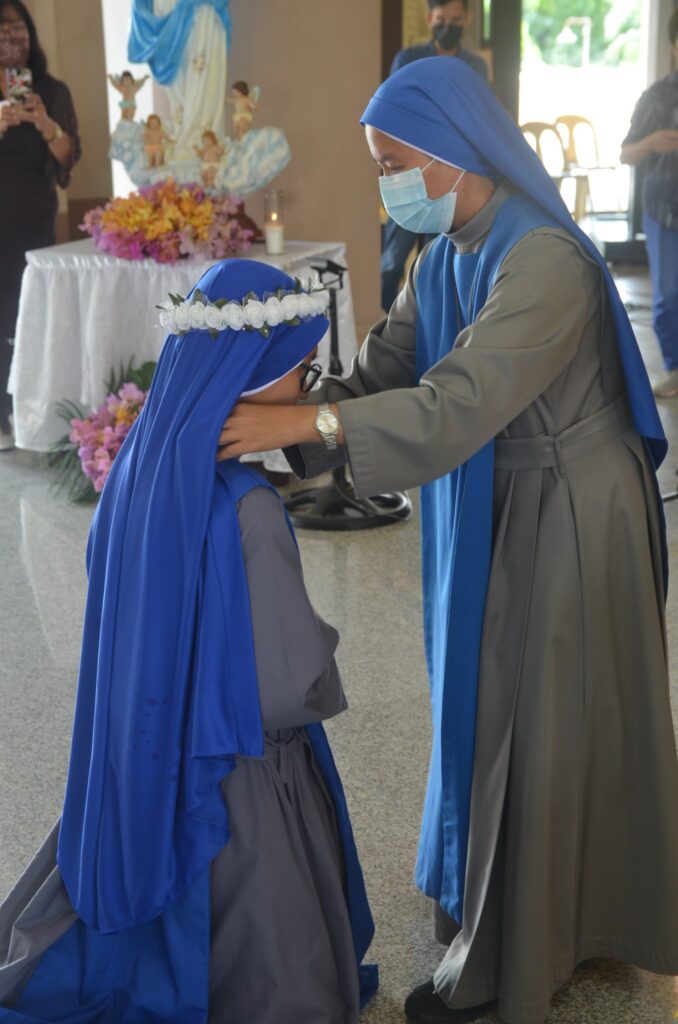Servants of the Lord
and the Virgin of Matará
Our Name
"Servants of the Lord and the Virgin of Matará":
Why this Name?
From Fr. Buela’s book “Las Servidoras I”
Why did the Sisters of the feminine branch of the Institute of the Incarnate Word decide to be identified with the Cross of Matará, in the first half of March 1988?
For several reasons:
1. Because on it, Our Lord and the blessed Virgin are present. The authors of the booklet “The Cross of Matará” describe them as follows: “On the horizontal beam an image of Our Lord stands out and extends to the vertical beam. The figure of the body of Jesus Christ has very original stylized features: the waist is extremely narrow; the thorax widens with a movement that ends with the arms extended in a crucified position. A crown rests on the head and, from behind, a halo is clearly seen. The incised skirt begins from the waist and covers half of his thighs, the legs are separated and loose. The feet are resting on a support, according to the Jewish custom […]. A brilliant female figure, with a crown and a halo and carrying a scepter in her hand stands out. This figure with the features of a Spanish lady is undoubtedly the Virgin Mary, whose presence at the foot of the Cross is underlined by the evangelist. The crown and scepter represent her mission of eternal and universal reign. It should be noted that technically her skirt is incised in the same way as that of the Lord’s. It is well known that the Lord and the Virgin constitute what our spirituality desires to be.


2. Because the Lord is crucified and we “resolved to know nothing … except Jesus Christ, and him crucified” (1 Cor 2:2), “through which the world has been crucified to me, and I to the world”. (Gal 6:14).
3. Because it is a Cross, and we must live like St. Paul: I will glory only in the Cross of our Lord Jesus Christ (Gal 6,14). It is the Cross that “is producing for us an eternal weight of glory beyond all comparison.”(2 Cor 4:17).
4. Because there at the foot of the Cross was the First Servant of the Lord: Mary Most Holy. And this should remind us not only of the reason, but also the place, the role and the mission of the “Servants” after the example of the Virgin and the other women:
- In the first place, the Blessed Virgin, who, considering herself as a handmaid, a servant, (“Behold, I am the handmaid of the Lord,” Lk 1:38), made possible that the Word take “the form of a slave” (Phil 2:7) in her most pure womb. And thus, the prophecy of Isaiah of the Suffering Servant was fulfilled (Is 42:1-4), because God “has looked upon his handmaid’s lowliness” (Lk 1:48), that is Mary’s.
- Those who accompanied the Lord when “afterward he journeyed from one town and village to another, preaching and proclaiming the good news of the kingdom of God. Accompanying him were … some women who had been cured of evil spirits and infirmities, Mary, called Magdalene…, Joanna, the wife of Herod’s steward Chuza, Susanna, and many others (Lk 8:1-3) …who and ministered to him…” (Mk 15,41).
- Those who stood by the cross: “There were many women there, […] Among them were… (Mt 27:55-57; Mk 15:40), standing by the Cross of Jesus….:
- Mary, his Mother (Jn 19:25).
- Mary Magdalene.
- Mary Salome, the sister of his Mother, that is, his aunt, wife of Zebedee, mother of James and of John.
- Mary of Cleophas, sister of St. Joseph, that is, his aunt, wife of Cleophas, the mother of the younger James and of Joses.
- Many other women (Mk 15,41)
They were those who:
- had followed Jesus from Galilee, (Mt 27:55; Lk 23:49);
- ministered to him (Mk 15:41; Mt 27:55) when he was in Galilee.
- had come up with him to Jerusalem (Mk 15:41);


- There were many women looking on (Mt 27:55; Mk 15:40) the sacrifice of the Cross: they saw these events (Lk 23:49).
- The first to go to the tomb on Easter Sunday: Mary Magdalene, Mary, the mother of James, and Salome bought spices so that they might anoint him. The same ones “who went away quickly from the tomb, fearful yet overjoyed, and ran to announce this to his disciples. (Mt 28:8), becoming messengers of the mystery of the resurrection.
- Likewise, the Servant par excellence continues to serve the apostles of her Son throughout the ages, together with other women, as it happened in the primitive Church: All these devoted themselves with one accord to prayer, together with some women, and Mary the mother of Jesus, and his brothers. (Acts 1:14). I want to mention here that for St. Louis Marie of Montfort in speaking of sons, slaves and servants, these are synonymous, therefore it is the same to be and to be called servant, slave or daughter.
5. We have also chosen the Cross of Matará because it is properly speaking a precious altarpiece, where the central motives of our spirituality are carved. We have already referred to the Lord and the Virgin, but the artist also describes mysteries of the Lord’s life such as the Incarnation and the Nativity (the comet = the star of Bethlehem), the Redemption (the rooster = Peter’s denials; the scourging or cords; the crown of thorns; the hammer; the nails; the ladder; the lance…), the Eucharist, etc.
6. Also, being one of the oldest crosses (year 1594) preserved in the territory of our country, it will remind us of the duties towards the “terra patrum” (the land of the fathers) that the fourth commandment commands us, and its Christian roots. And at the time, it seemed that it was a very beautiful idea that a religious congregation founded in Argentina and by Argentines, should bear this name that unites us with the first inhabitants of this continent.
7.In addition, since 1982 it is on the cover of the Roman Missal in its Argentinean edition, as ordered by the Argentinean Episcopate. This will motivate us to pray always for our Pastors, the Bishops and the priests united to them. This should be done even in the case that in new editions of the Roman Missal (Argentinean edition) the Cross of Matará would no longer be on the cover.


8. It is also a beautiful example of evangelization of culture or inculturation of the Gospel, the specific goal of our religious Institutes. As demonstrated by the fact that it was carved by an indigenous person who made a true work of art: “…under one direction, the workmanship was indigenous and very skillful, achieving a style by employing certain resources for the treatment of the figures, for example, the widening of the torso, the movement of the rooster and the tongues of fire, the posture of the well-balanced female figure and the harmonious integration of all the elements. Thus the artwork is not only rich in content, but also in artistic values and constitutes an artwork of Hispanic-Indian art. Let us pay attention to the meticulous work of each one of the carved figures or symbols, the small incisions on the skirts, on the comet, on the hair of Christ, the priestly attitude of the cacique, the ornamentation of the borders that give a neat finish and the separation by lines and zones without carving of the said figures or motifs. The disposition is the object of attention because it forms a perfect unity and this aspect is very important, since it is in direct relation with the intention pursued and already enunciated. Its religious significance and liturgical function are real”. This carving was made on fibrous wood of the regional flora, the mistol (Ziziphus mistol), united its two parts by two wooden nails (dowels), the assembly is perfect, etc. There is a cultural interrelation whose “results are evident in the Cross of Matará, because there, in that place of Salado, the Hispanic cultural, religious and artistic features (and a whole tradition), became elements of the indigenous people, who assimilated them into their culture, merging with these features from their own tradition, executing with their hands and their sensitivity this new inheritance that was bequeathed. This extraordinary case of transculturation, through time and space, was made possible by the profound work of the Society of Jesus in the colonial period” . The same name that marks the town where it was located: Matará, is the toponym of the tribe of the Mataráes Indians of the area. In addition, it should be noted that the cross was made to transmit the Gospel: the Matará Cross had a clear catechetical purpose. It is important to value the creativity of the artist, his patient work and the durability of his work through time, as an example to imitate.
9. This Cross is an eloquent sign of the great task carried out by the Church in these lands. In a special way two exemplary missionaries are linked to the Mataráes: one, Father Alonso de Barzana or Barcena, Jesuit, who passed through Matará and is known as the Apostle of Peru and missioned the entire area; another, the great Saint Frances Solano, who spent more than six years in the place that would later become the territory of the Argentine Republic, from the year 1590 to 1597. He was probably in Santiago del Estero some days in 1592 (miracle of the Rio Hondo), between the years 1592 and 1593 for a longer period (miracle of the lengthening of the strait) traveling along the rivers Salado and Dulce, he missionized and converted the natives who “were recognized by the generic name of Matarás”. In his crusade for the Christianization of the natives “the waters of the Salado […]were salutary poured upon the foreheads of countless savage natives.


10. Finally, our Congregation “the Incarnate Word” carried out its first Popular Mission outside the Diocese of San Rafael in Matará in 1985. Marcelo Javier Morsella, the first member of our Religious Family that passed away, was captivated with that town and its people to the point that he composed a zamba, whose music he brought to Heaven and whose lyrics -only the first two stanzas- were found on a card that fell out of a pocket of his pants[…].
In this way, the feminine branch of our Congregation strongly complements what we wanted to do by naming the masculine branch after the Incarnate Word, because the Incarnation was redemptive, and the Redemption was only possible through the Incarnation. It is thus that the Word becomes flesh in order to go to the cross, and the cross is possible because Christ became incarnate.
Because of all these things, the Cross where the Lord and the Virgin of Matará are constitutes a very beautiful program of life that those who are proud to bear this name should strive to achieve, with the grace of God, which is never lacking if one does what one has to do. To pass on to the new generations the high ideals expressed in this Cross should be a renewed commitment of each and every member of our Religious Family throughout the ages so that the Gospel of Jesus Christ may resound in every corner of the earth: “Go into all the world and preach the Gospel” (Mk 16:15).
